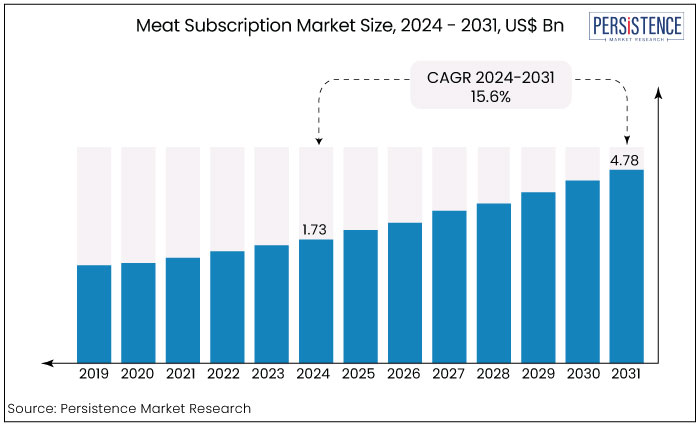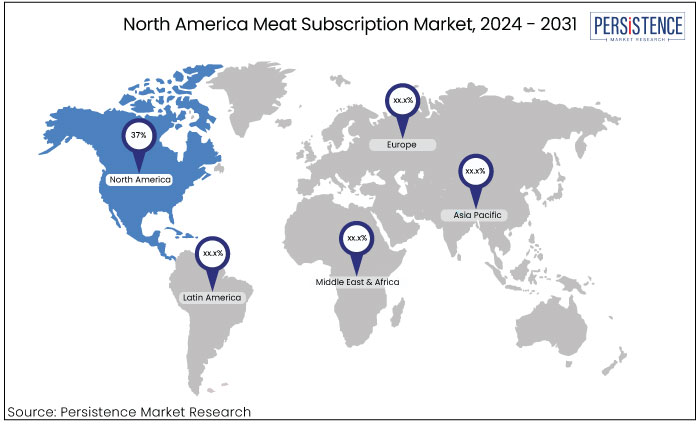Industry: Food and Beverages
Published Date: October-2024
Format: PPT*, PDF, EXCEL
Delivery Timelines: Contact Sales
Number of Pages: 188
Report ID: PMRREP33320
The meat subscription market is estimated to increase from US$1.73 Bn in 2024 to US$4.78 Bn by 2031. The market is projected to record a CAGR of 15.6% during the forecast period from 2024 to 2031. About 72% of meat subscription customers prefer subscription services that offer customizable boxes tailored to their dietary preferences and meat types such as beef, chicken, pork, seafood.
Consumers are becoming increasingly concerned about sustainability and ethical sourcing, with around 60% of subscribers prioritizing meat sourced from grass-fed, organic, or humanely-raised animals. Beef-based products, including grass-fed and organic beef, represent the largest segment, comprising around 40% of the overall market.

Key Highlights of the Market
|
Market Attributes |
Key Insights |
|
Meat Subscription Market Size (2024E) |
US$ 1.73 Bn |
|
Projected Market Value (2031F) |
US$ 4.78 Bn |
|
Global Market Growth Rate (CAGR 2024 to 2031) |
15.6% |
|
Historical Market Growth Rate (CAGR 2019 to 2023) |
29.4% |
|
Region |
Market Share in 2024 |
|
North America |
37% |
North America is a prominent market for meat subscriptions. It is projected that the region I estimated to be valued at US$ 2.5 Billion by 2033. Chicken was the most consumed meat in Canada in 2023. Canadians consumed around 34 Kg per capita chicken, which has increased by almost 9 Kg since the last decade. This growing consumption is likely to create an opportunity for the market.
The market in the United States is expected to be worth US$ 2 Billion by 2031, with an absolute growth of US$ 1.4 Billion from 2024 to 2031. The market in the country exhibited a CAGR of 29.4% from 2019 to 2023 and is projected to expand at a CAGR of 15.6% from 2024 to 2031.
The consumption of beef amounted to around 26.7 Kg per capita on an annual basis in 2023. The U.S. market is expected to grow in the coming years due to a rise in demand for high-quality, sustainable meat products and the increased demand for direct-to-consumer food delivery services.
Consumers in the United States are becoming more concerned about their food choices, which may affect the environment. Many consumers are ready to pay a premium for meat products that are sourced from sustainable and ethical sources.

|
Category |
Market Share in 2024 |
|
Meat Type - Beef |
27% |
Based on meat type, the market is divided into beef, chicken, pork, seafood, and lamb, where the beef segment dominated the market. The increasing demand for beef is due to technology enhancing sustainability, safety, and efficiency within the cattle business. Data analytics and GPS-guided apparatus are two instances of precise instruments that are improving cow farming methodologies.
Blockchain technology guarantees food safety by improving traceability. Moreover, innovations in meat processing, including robots and automation, are enhancing the output quality. The market is rapidly rising due to these technological improvements, which reduce costs and waste while meeting the increasing global demand for premium beef products. Consumers are increasingly preferring a diet rich in necessary proteins.
|
Category |
Market Share in 2024 |
|
Subscription Type - Monthly |
40% |
Based on subscription type, the market is divided into weekly, monthly, quarterly, half yearly and annually, where the monthly subscription type dominates the market. Monthly Meat Subscription is projected to witness the fastest growth as it has grown at a CAGR of 33.6% from 2019 to 2023 and is expected to grow at a CAGR of 14.5% from 2024 to 2031.
A monthly subscription gives the business consistent and predictable revenue and increases customer retention, relationship engagement, and stability for the business. Members who subscribe to monthly subscriptions are more likely to stay engaged or involved with the business. Subscription boxes are cheaper than the stores, so they are also affordable to consumers, which is why the monthly subscription type dominates the segmentation.
Meat subscription services offer a variety of meat products, including beef, pork, chicken, lamb, and others, allowing customers to choose from a wide range of options.
Health and wellness trends are fueling the demand for organic and grass-fed meat, which are known for their health benefits such as being a good source of omega-3s, vitamins, and minerals. The rise of e-commerce and home delivery services is expected to further boost the demand for these health-conscious meat subscription services, reassuring consumers about their dietary choices.
Consumers can easily and conveniently obtain premium meat products through meat subscription services, avoiding visiting a grocery store. Due to the convenience and ease of access, consumers are shifting towards subscription food services. Young people had significant spending on food subscriptions, over US$200 per capita. This growing trend of subscription services is expected to increase demand for meat subscription services.
The average annual consumption of seafood worldwide was about 19.9 Kg per capita, and in 2020, the consumption of seafood was over 20.5 Kg per capita. With increasing seafood consumption, the demand for seafood subscriptions will likely increase in the forecast period.
The companies providing meat subscriptions offer meat at lower prices for bulk purchases and customization on orders for specific meat cuts and the frequency of delivery. Because of rising income, increasing population, and expanding knowledge of the health advantages of consuming high-quality meat products, consumers are shifting to the subscription model of meat consumption.
During the period from 2019 to 2023, the meat subscription market experienced steady growth, driven by the rise of e-commerce and a shift in consumer preferences toward convenience. The COVID-19 pandemic accelerated the demand for online food delivery services, with many consumers avoiding grocery stores and opting for subscription models.
Health-conscious trends, notably a preference for organic, grass-fed, and ethically sourced meats, further fueled the market. Companies like ButcherBox and Crowd Cow capitalized on these trends, expanding their customer base. The market also benefited from increasing awareness around sustainability, pushing more consumers to seek higher-quality, ethically sourced meat products. However, challenges like cold-chain logistics and high subscription costs limited the growth to a certain extent.
Over the forecast period, the meat subscription market is projected to grow significantly. Factors driving this include the continued expansion of e-commerce, rising disposable incomes, and an increasing focus on sustainability and animal welfare.
Technological innovations such as AI-driven personalization and improved cold-chain logistics will also enhance user experience and mitigate spoilage concerns. The demand for seafood subscriptions is also expected to rise, fueled by growing seafood consumption. Furthermore, younger consumers, particularly millennials and Gen Z, are anticipated to drive higher spending on food subscriptions, solidifying the market’s future growth trajectory.
E-commerce Expansion and Consumer Shift to Online Shopping
The widespread expansion of e-commerce platforms has been a major growth driver in the meat subscription market. With the convenience of online shopping, consumers are increasingly opting for subscription models that deliver high-quality, customizable meat products directly to their homes.
Post-pandemic, this trend has continued as more consumers appreciate the ease of subscription services. Online platforms also allow meat subscription providers to reach broader geographic areas, extending their customer base. Enhanced digital interfaces and mobile app integrations have further improved customer experience, allowing users to manage subscriptions easily, select delivery frequencies, and customize orders.
As internet penetration grows globally, particularly in emerging markets, the meat subscription market benefits from increased digital engagement and rising consumer preferences for the convenience of e-commerce-driven services, contributing to steady long-term growth.
Rising Consumer Focus on Health, Wellness, and Sustainability
The increasing consumer focus on health and wellness and concerns about sustainability are other key growth drivers for the meat subscription market.
Consumers are becoming more conscious of their dietary choices, leading to a surge in demand for organic, grass-fed, and ethically sourced meat products. These options are perceived to be healthier, containing fewer chemicals and antibiotics while offering higher nutrients such as omega-3 fatty acids, vitamins, and minerals.
Concerns over animal welfare and environmental sustainability drive consumers to seek suppliers that prioritize ethical sourcing practices. Subscription services like ButcherBox and Crowd Cow have successfully tapped this demand by offering premium, ethically sourced meat products. This alignment with consumer values reassures the audience that these services are not just meeting demand but also contributing to a more significant societal shift towards conscious consumerism.
Complying with Food Safety Regulations and Overseeing Supply Chains
Complying with food safety and hygiene requirements presents a difficulty for meat subscription providers. Businesses operating in numerous locations need help adhering to different areas' regulatory requirements.
Ensuring a seamless and sustainable supply chain is essential for the prompt delivery of perishable and fresh products while preserving quality. Last-mile distribution faces challenges, especially in heavily populated urban regions.
Customer satisfaction is contingent upon the capacity to preserve the freshness and quality of meat products throughout delivery and transportation. Establishing an efficient cold chain logistics infrastructure to avert spoilage and contamination poses an additional obstacle to the sales of subscription-based meat.
Introduction of Cloud Kitchens and Extensive Availability of Meat
Meat is widely available in the market, including beef, hog, chicken, lamb, and others. The global population of smartphone users is increasing swiftly, hence facilitating this technological advancement is aiding the growth of online meal delivery businesses.
The expansion of the meat subscription business in tier-2 and tier-3 cities is propelled by the establishment and accessibility of delivery-only kitchens in regions with limited restaurant or eatery choices. The use of marketing strategies by major industry participants also facilitates the growth of the meat subscription market size. The industry is propelled by incentives offered by producers, like discounts and subscriptions.
Companies providing meat subscriptions provide lower prices for bulk purchases, permit consumers to customize their orders for specific pieces of meat, and allow them to select the frequency of delivery. Factors such as urban population expansion and heightened awareness of premium meat products' health advantages drive customers toward a subscription model for meat consumption.
The meat subscription market is not just a niche segment anymore but a rapidly growing industry. With a multitude of players offering differentiated products based on quality, sourcing practices, and customization, the market is ripe with potential.
Key players like ButcherBox, Crowd Cow, and Porter Road are leading the way, focusing on organic, grass-fed, and ethically sourced meats, catering to health-conscious and sustainability-driven consumers.
Smaller and regional players, such as Farmison & Co. and Wild Pastures, focus on niche offerings like heritage breed meats and regenerative agriculture partnerships, targeting environmentally-conscious segments.
Competitive differentiation stems from the ability to offer premium products, flexible subscription plans, and personalized experiences. As demand rises for healthier, ethically sourced meats, competition will intensify, with innovation in cold-chain logistics and sustainable packaging playing critical roles in market expansion.
Recent Industry Developments in the Meat Subscription Market
|
Attributes |
Details |
|
Forecast Period |
2024 to 2031 |
|
Historical Data Available for |
2019 to 2023 |
|
Market Analysis |
US$ Billion for Value |
|
Key Regions Covered |
|
|
Key Market Segments Covered |
|
|
Key Companies Profiled in the Report |
|
|
Report Coverage |
|
|
Customization & Pricing |
Available upon request |
By Meat Type
By Subscription Type
By Region
To know more about delivery timeline for this report Contact Sales

The meat subscription market is estimated to be valued at US$4.78 billion by 2031.
The market is projected to exhibit a CAGR of 15.6% over the forecast period.
Butcher Box, Porter Road Butcher, CARNIVORECLUB.CO., are some of the leading key players.
North America is the leading regional market for meat subscription.
Beef meat type leads the market with significant market share.